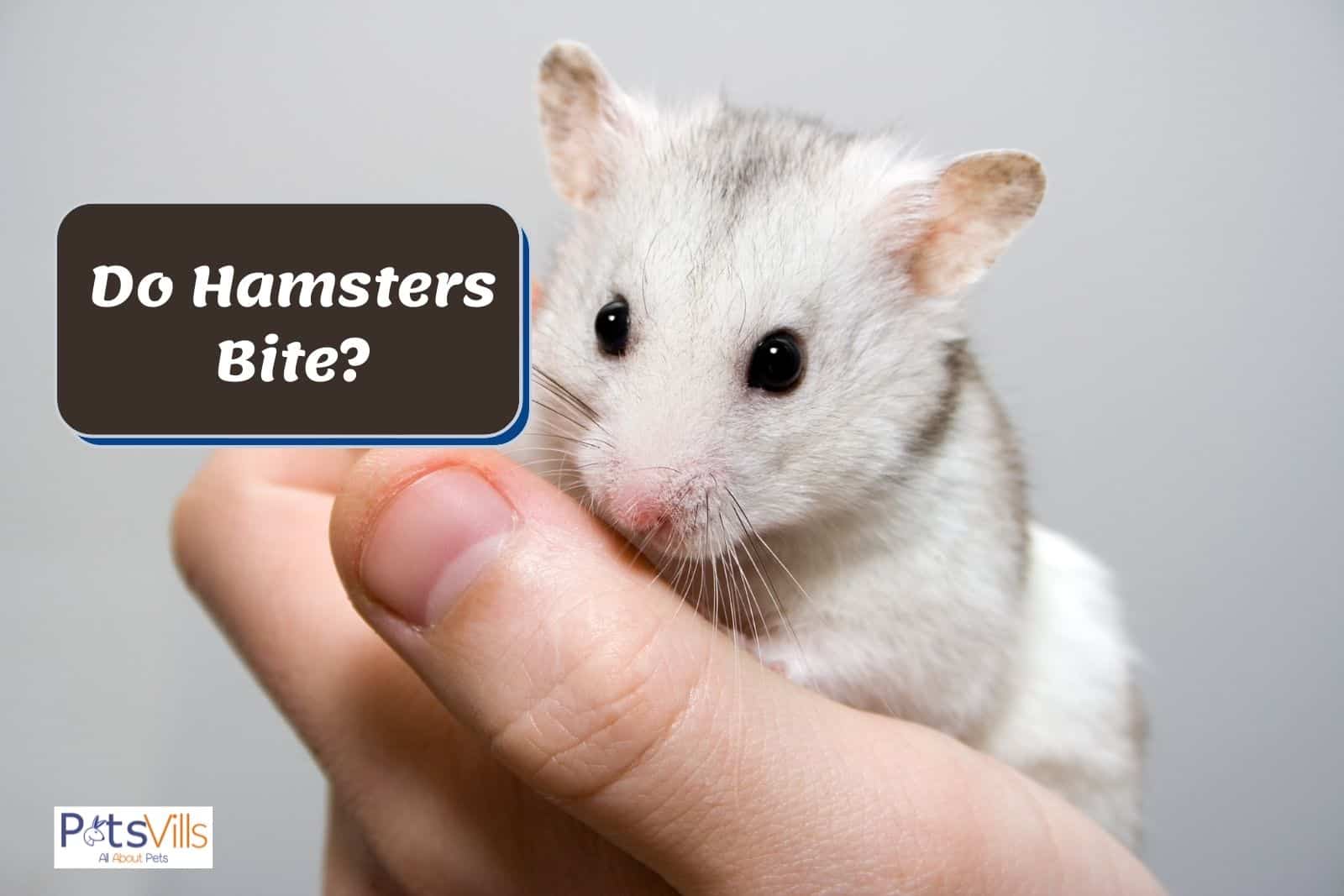Hamsters’ teeth are constantly growing during their adolescent and adult life. It’s vital to supply your hamster with the correct diet and toys that they can chew on.
Do hamsters bite? Hamsters only really bite when they feel threatened or scared. Before handling your hamster wash your hamsters as the hamster might mistake you for food if they smell a scent.
If a hamster was to bite, they could do some harm, but do hamsters bite humans that often?
Table of Contents
Do Hamsters Bite?

Hamsters have sixteen teeth [1] and can deliver a painful bite when threatened or scared.
Hamsters do have a bit of a bad reputation for biting.
Most people think hamsters regularly bite to be aggressive.
However, hamsters typically only bite when they are scared or nervous.
This is often misinterpreted as aggression.
Hamsters are prey animals, and they use biting as a defense mechanism. They are small and easy targets for predators, so biting is the only tool for protection.
Hamsters, especially untamed and young ones, can mistake their owners for a predator who will hurt them and retaliate with a bite.
It would be best if you gained your hamster’s trust to help him understand that you are not to be feared.
Make sure to also read our separate post, “Why does my hamster bite me?”
Here are some tips on how you can keep your hamsters calm.
How to Train Your Hamster to Stop Biting You
Training your hamster to stop biting you can be a long process. Each hamster is unique, which means it’s difficult to estimate how long it will take before your hamster is tame.
Some hamsters could become tame in a week. Others might take months or even longer.
It’s essential to be patient and consistent when training your hamster to stop biting you. Regular training sessions will help your hamster learn.
If you’re not persistent with training your hamster, then it will take much longer to tame him.
When you begin training your hamster, you need to wash your hands with unscented soap before you handle him.
Hamsters have very poor eyesight [2] and rely heavily on smell, so they could mistake your hands for food and bite you.
By washing your hands, you are getting rid of any scents that could make your hamster think you are a snack.
Take a look at this video for some great tips.
When you want to train your hamster, make sure you do it when he is already awake. This might mean staying up a bit later than usual as hamsters are more active at night.
Waking up a hamster can make him grumpy and irritated (like most of us when we’re disturbed!), which will make him more likely to bite.
If you have not had your hamster long, you should give him some time to settle in first. It would be best if you left him alone for at least three days, but preferably longer.
Here are some signs that you hamster is stressed so you can help them out!
Steps To Take To Ensure Your New Hamster Doesn’t Bite You

After your hamster has had time to settle in, you can start talking to your hamster through the cage bars to help him get accustomed to your presence and your voice.
Speak in a soft and gentle tone, so you don’t startle him.
Next, you can begin introducing your hand to your hamster.
You should start slow by just resting your hand in your hamster’s cage. If he approaches you, don’t panic.
Let him sniff your hand. He’s just curious and wants to make sure your hand isn’t a danger to him.
If this introduction goes well, you can start hand feeding your hamster. Offer a tasty treat to your hamster and see if he takes it from you.
You could try stroking your hamster with a finger if he is already comfortable taking treats from you. Avoid petting his head. Instead, lightly stroke his body. Watch his reaction.
If he freezes, runs away, or slinks down when you pet him, then he might not be ready to be touched or handled.
Go at your hamster’s pace and repeat previous steps if he is still not ready to be touched.
If your hamster raises his paws, shows his teeth, or lets out a hissing or growling noise, then respect his space and leave him alone. These are all warning signs that are usually followed by a bite.
If your hamster displays any of these signs, he lets you know that he does not want to be bothered and isn’t in the mood to interact with you.
End the training session and try the next day again.
If you’re wondering why your hamster is climbing the glass, check out our article “why is my hamster trying to climb the glass” for possible reasons and solutions.
The Steps You Should Take if Your Hamster Bites You
Being bitten by a hamster (or any animal!) is never fun. Even though these furry friends are small, they can deliver an excruciating bite to draw blood.
If your hamster does bite you, remain calm. Being bitten, especially if it was unexpected, can take you by surprise. It’s still important not to scream, yell, or thrash your arms about.
This could result in your hamster biting again.
If you were holding your hamster when the bite occurred, make sure you do not drop him. Swiftly hand him to another person so you can take care of your cut or put him back into his cage.
If your hamster bites you when you are handling him, then it is usually a good idea to leave him alone for a bit.
This means putting your hamster back into his cage so he can calm down for a little while.
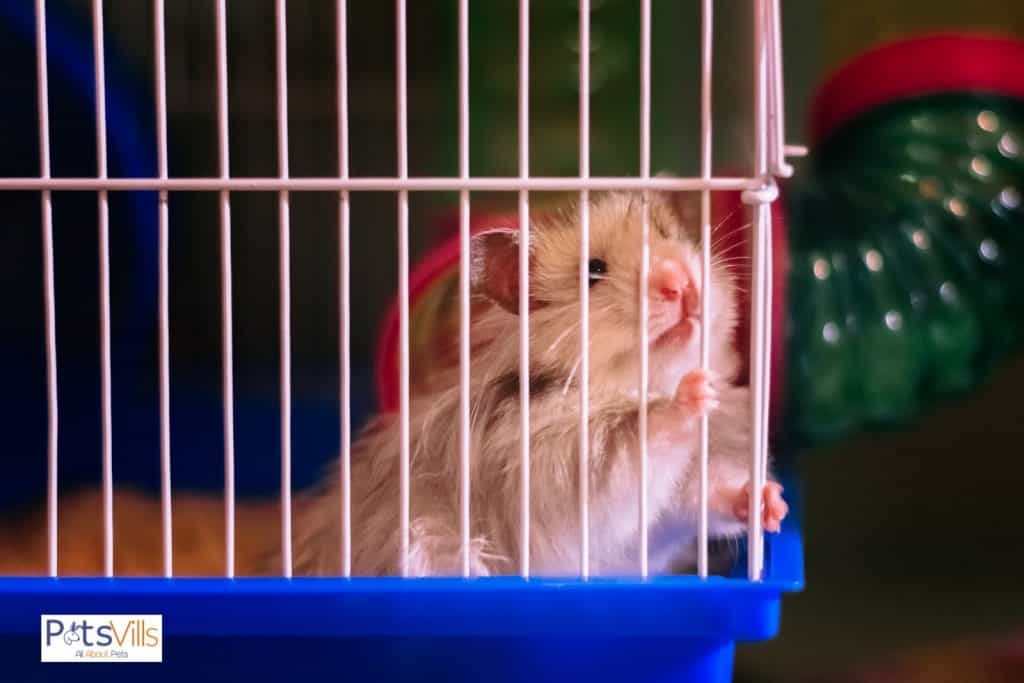
Hamsters instinctively bite out of fear [3] or when they are anxious/nervous, so chances are your hamster was letting you know he’d had enough.
Although hamster bites are painful, they are rarely severe. Wash the area where you were bitten under some water to prevent infection.
If your hamster has drawn blood, then you might want to put a plaster over where you were bitten.
You should never, under any circumstances, punish your hamster for biting. Your hamster didn’t bite to be mean or upset you. He was acting out of fear.
You shouldn’t feel disheartened if your hamster does bite you. Sometimes it can be difficult to judge when a hamster will bite, especially if they didn’t give you any warning signs beforehand.
It’s a good idea to expect a bite when you are handling a new hamster or one that hasn’t been tamed. This can make it less of a shock if your hamster does nip you.
Gradually getting your hamster used to human contact can help him stop biting and make him act more confident and comfortable around you.
Use Leather Gloves
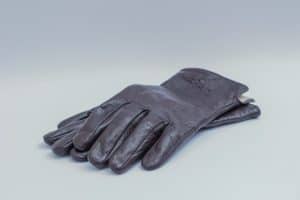
If your hamster bites regularly and you feel nervous when handling him, then you could wear a pair of leather gloves.
Leather gloves can help protect you from bites as your hamster’s teeth won’t be able to penetrate through the material.
However, use caution when wearing gloves.
Some hamsters might mistake them for a chew toy or try and gnaw at them to use the material for their nesting area.
Keep Your Hamster Away From Other Animals
You should always keep your hamster away from other animals. This includes other hamsters.
Syrian hamsters are strictly solitary creatures and will fight with other hamsters [4]. The only time a hamster would willingly meet another is hamster is during mating.
Even dwarf hamsters, who are usually more social, should not be mixed with other dwarf hamsters they are unfamiliar with.
As well as other hamsters, you should make sure your hamster does not come into contact with other animals, such as dogs and cats.
The presence of other animals can be extremely stressful for hamsters, which can make them more aggressive and defensive than usual, leading to biting.
Gaining The Trust of Your Hamster
Gaining your hamster’s trust is crucial to tame him and make him feel comfortable around you. A hamster who feels confident around you is less likely to bite.
To gain the trust of your hamster, you should begin by placing your hand into his cage. Wait for him to come up to it to investigate.
If your hamster shows no interest in your hand, don’t worry. Give him time.
Continue to put your hand into your hamster’s cage daily to help him realize that your hand (and you!) are not going to hurt him.
Food and treats are the best tools for taming your hamster.

You can feed store-bought treats now and again, but don’t overdo it. Store-bought treats are usually very unhealthy.
More healthy alternatives to feed your hamster include fruits, vegetables, unsalted peanuts, and sunflower seeds.
Always feed these in moderation too. Peanuts and sunflower seeds are high in fat, and overfeeding fruits and vegetables can cause diarrhea in hamsters.
Instead of just dropping these treats into your hamster’s cage, you should hand feed him. Place the treat in your hand and remain very still, so you don’t frighten your hamster.
Wait for your hamster to take the treat from your hand. This might take some time or more training sessions before your hamster feels comfortable going up to your hand.
Initially, your hamster might take the treat and runoff. However, eventually, he should feel comfortable enough to sit on your hand as he eats (or stores away) his treat.
Here’s a great video to watch!
The Dos and Don’ts When Dealing With Hamster (Relate This to Them Biting)
Dos
- Always ensure your hamster has access to water.
You should change your hamster’s water daily.
You can use a water bottle or water dish, but make sure the dish is heavy enough that it can’t be knocked over.
If you’re using a water bottle, it’s a good idea to invest in a metal shield to slide it into so your hamster can’t chew on the plastic.
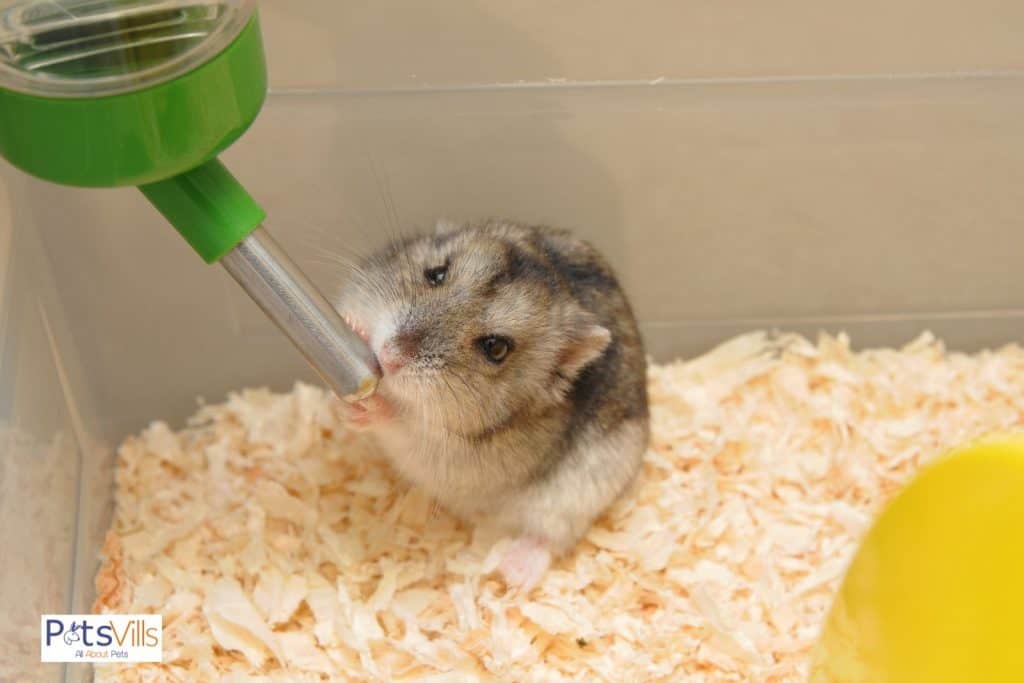
- Provide chew toys
Hamsters need to chew toys to help wear their teeth down. Overgrown teeth in hamsters require a trip to the vets as they can be painful and make it difficult to eat and drink.
To prevent this from happening, give your hamster chew toys to gnaw on. Wooden chew toys should be used [5].
Plastic toys can be toxic. If your hamster ingests small pieces, it nibbles off.
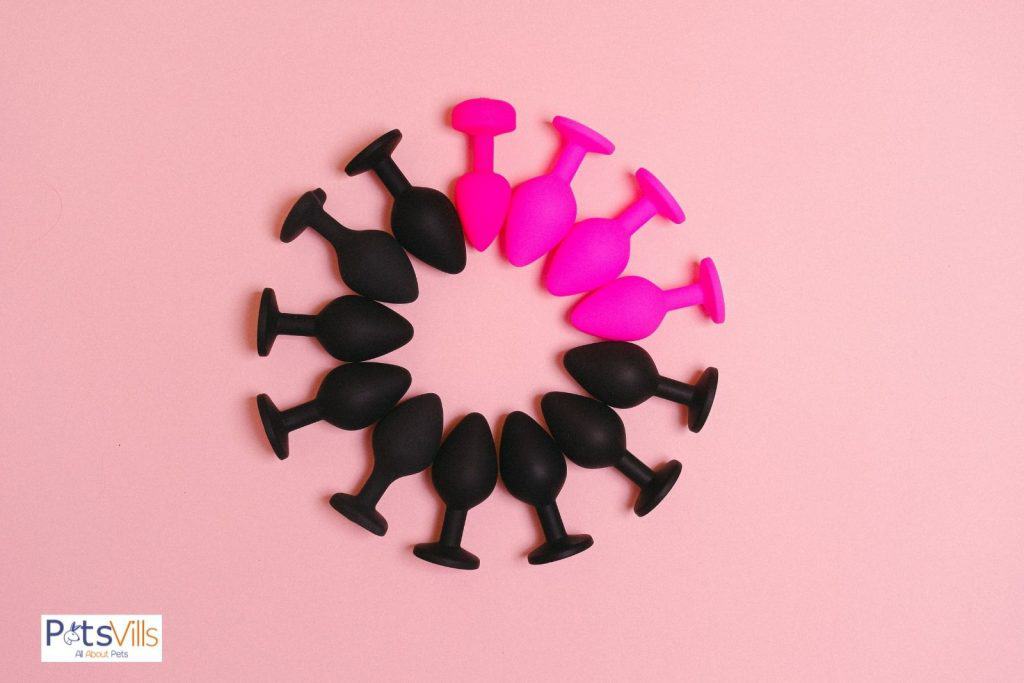
Related: Is Cardboard Safe for Hamsters?
- Clean your hamster’s cage regularly
You need to clean your hamster’s habitat every one to two weeks. Living in unsanitary conditions can be detrimental to your hamster’s health.
The ammonia in his urine can cause respiratory infections and other problems.
Besides, it’s never nice to live in an unclean environment! You can reduce the time and work you need to set aside when cleaning your hamster’s cage by doing regular spot cleans.
Spot cleans involve disposing of sodden and dirty bedding every day or so, as well as tidying the area.
Check out our article on how and when to clean your hamster’s cage. It is important not to clean them out too often as it can cause additional stress on your hamster.
- Provide your hamster with a wheel
Wheels are mandatory for hamsters, so you should always ensure your hamster has to access one.
For Syrian hamsters, a wheel at least 10 inches is adequate (6.5 for dwarf hamsters).
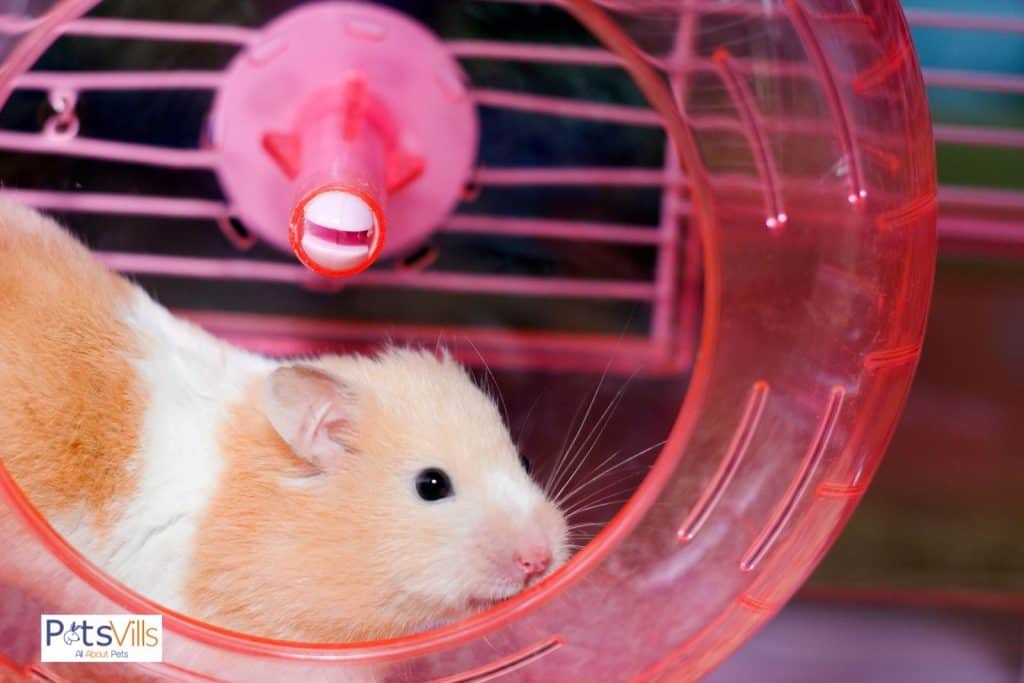
READ MORE: How many teeth do hamsters have?
Don’ts
- Don’t use unsafe bedding
Sawdust and Pine/Cedarwood shavings are unsuitable bedding options for hamsters. As well as being incredibly dusty, they also contain toxic chemicals that could hurt your hamster.
Safe bedding includes paper-based materials, bedding with cellulose, and Aspen wood shavings.
- Don’t place your hamster’s cage in direct sunlight or near radiators/draughts.
You don’t want your hamster to overheat or become too cold. Both these things can be hazardous for your hamster.
- Don’t punish or purposely scare your hamster
If your hamster bites you or goes to the toilet in your hand, don’t punish him. He is simply scared or nervous.
Similarly, you should never purposely scare your hamster. This can be extremely stressful and make it harder for him to trust you.
- Don’t let other animals have access to your hamster
A dog barking at your hamster or a cat stalking him can be very scary. Make sure your hamster’s cage is in a room where other animals can’t bother him. You should also make certain other animals can’t get to your hamster when you’re playing with him.
FAQs
What happens if a hamster bites you?
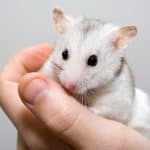
When a hamster bites you, it is usually because they feel threatened. Depending on how hard the bite is, you might need medical attention.
How painful is a hamster bite?
Some hamster bites are more painful than others. It depends on how hard the hamster bites you, but it can be pretty painful.
How do you get your hamster to stop biting?
To train your hamster to stop biting you, you need to properly introduce yourself by talking to your hamster in a gentle tone and letting your hamster smell your scent.
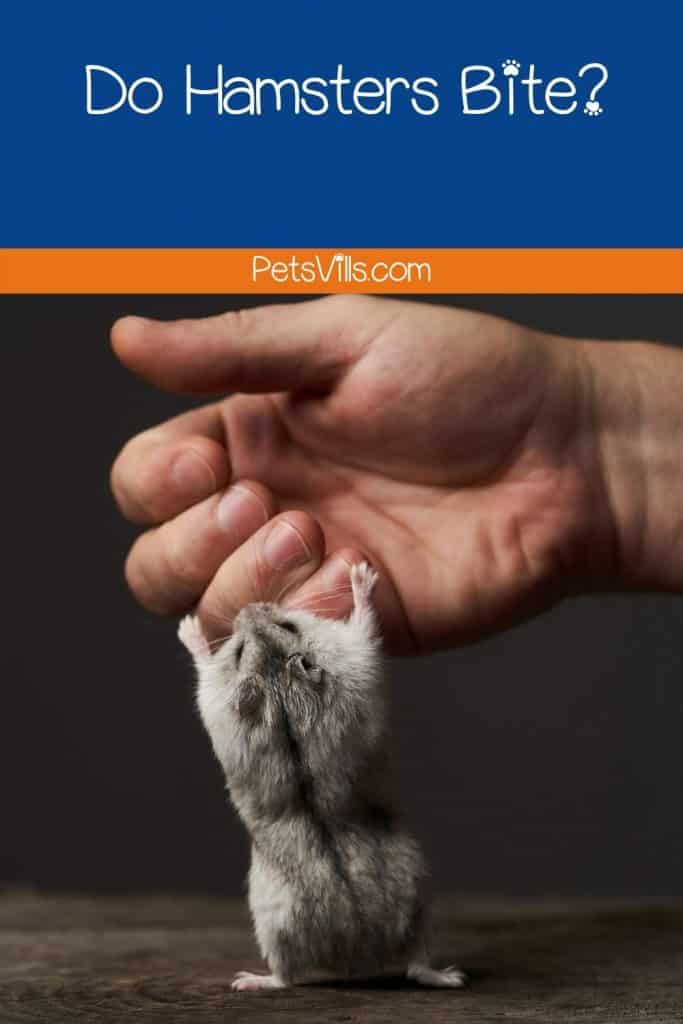
Did your hamster ever bite you? Let us know in the comments section!
Resources
- 1. Manual B. Hamster Facts: Diet, Habits & Types of Hamsters [Internet]. Live Science. Live Science; 2014. Available from: https://www.livescience.com/27169-hamsters.html
- 2. Miedel EL, Hankenson FC. Biology and Diseases of Hamsters. Laboratory Animal Medicine. 2015;209–45.
- 3. Lin D, Boyle MP, Dollar P, Lee H, Lein ES, Perona P, et al. Functional identification of an aggression locus in the mouse hypothalamus. Nature [Internet]. 2011 [cited 2020 Aug 25];470:221–6. Available from: https://www.nature.com/articles/nature09736#Sec16
- 4. Pritchett-Corning KR, Gaskill BN. Lack of Negative Effects on Syrian Hamsters and Mongolian Gerbils Housed in the Same Secondary Enclosure. Journal of the American Association for Laboratory Animal Science : JAALAS [Internet]. 2015 [cited 2022 Feb 16];54:261–6. Available from: https://www.ncbi.nlm.nih.gov/pmc/articles/PMC4460937/
- 5. How to Keep Hamster Teeth Healthy [Internet]. www.petmd.com. Available from: https://www.petmd.com/exotic/general-health/how-keep-hamster-teeth-healthy
Barry Stingmore is a British content writer living in Fuerteventura, Spain. An animal lover at heart, he shares his home with a dog and four rescue cats and has a passion for writing about animals big and small.
Barry loves finding answers to your animal-related questions, the more research involved the better! You can rely on him to find the facts.
Find him on FACEBOOK, TWITTER AND Linkedin
Read his latest ARTICLES.
Find more about him HERE.

